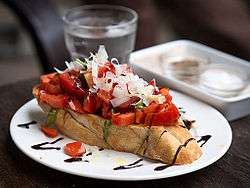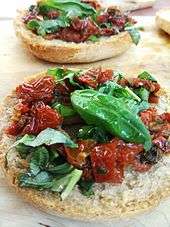Bruschetta
 Bruschetta topped with a tomato salad, caramelized balsamic vinegar, and Grana Padano | |
| Course | Antipasto |
|---|---|
| Place of origin | Italy |
| Serving temperature | Cold dish |
| Main ingredients | Bread, garlic, olive oil |
| Variations | Tomato, vegetables, beans, cured meat, cheese |
Bruschetta (Italian pronunciation: [bruˈsketta] (![]()
In Italy, bruschetta is often prepared using a brustolina grill. In the Abruzzo region of Italy a variation of bruschetta made with a salame called ventricina is served. Raw pork products and spices encased in pig bladder are aged and the paste spread on open slices of bread which are sometimes grilled.[2] This was a way of salvaging bread that was going stale.[3] In Tuscany it is called fettunta and it is usually served without toppings, especially in November, to taste the first oil of the season.[4]
History
Bruschetta originated in Italy during 16th century. However, stems of the dish can be traced back to Ancient Rome, when olive growers would bring their olives to a local olive press and taste a sample of their freshly pressed oil using a slice of bread.[5]
Pronunciation and usage
In Italian and non-English-speaking countries, bruschetta is pronounced [bruˈsketta]. In English-speaking countries, it is sometimes anglicised as /bruːˈʃɛtə/.[6]
The noun bruschetta (plural bruschette) comes from the Roman dialect verb bruscare, the equivalent of the Italian word abbrustolire which means 'to toast', or 'to roast over coals'.[7] Toasting bread and soaking it with freshly pressed olive oil may be "a practice probably as old as Rome itself".[8][9]
In the United States, the word is sometimes used to refer to a prepared topping, sold in jars and usually tomato-based, instead of the bread, a sense which is unknown in Italian.[9]
 Bruschetta with chopped tomatoes and basil
Bruschetta with chopped tomatoes and basil Bruschetta with olive oil and prosciutto
Bruschetta with olive oil and prosciutto
See also
- Garlic bread
- Crostini
- Crouton
- List of bread dishes
- List of toast dishes
- Pa amb tomàquet, a similar dish in Catalan cuisine
Notes and references
- ↑ "Bruschetta Trio". Oil and Vinegar company website. 2015. Retrieved 2015-12-05.
- ↑ "bruschetta". Hannah International Foods. 2010. Archived from the original on 2010-02-27. Retrieved 2010-01-05.
- ↑ The Dictionary of Italian Food and Drink, John Mariani. Broadway Books. New York, 1998 p. 45
- ↑ "Fettunta Toasted bread with olive oil". Retrieved 21 March 2012.
- ↑ Sankalan Baidya. "11 Interesting Facts About Bruschetta". Retrieved 13 March 2018.
- ↑ "bruschetta". Merriam-Webster Online Dictionary. 2009. Retrieved 2008-02-22.
- ↑ Ayto, John (2003). An A to Z of Food and Drink. Oxford: Oxford University Press. p. 44.
- ↑ Marcella Hazan, Essentials of Classic Italian Cooking, ISBN 0307958302, s.v. Bruschetta—Roman Garlic Bread
- 1 2 Hartz-Seeley, Deborah S (August 21, 2008). "The Toast Of Italy: Bruschetta South Florida Chefs Put Their Own Spin on Traditional Dish". South Florida Sun-Sentinel. p. E7.
External links
| Wikibooks Cookbook has a recipe/module on |
| Wikimedia Commons has media related to Bruschetta. |